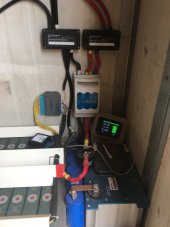Brandon8792
New Member
- Joined
- Nov 20, 2019
- Messages
- 57
Hello!
So I already have a 12kw Growatt inverter all in one, and 2 300ah lifepo4 packs in parallel together.
I know the lithium doesn’t have an issue pushing the power and I know the inverter doesn’t. However, it seems to put strain on the inverter (in my opinion) when I turn the stove on; or say start a welder and then stop and then start and then stop…
I was going to add 240v super capacitor into the ac line set to try to eliminate the startup load on the inverter and instead let the inverter slowly/somewhat quickly charge the capacitors back up… I guess like a supercapacitor in an audio setup… however I know that’s dc and don’t really see how I’ll make that work…
My mini splits are soft start, so then I thought about a soft start for the whole house, but then idk if a welder or stove would even work that way… so I’m just mainly worried about lifespan on the inverter with things like this. It seems that wouldn’t be very good on the inverter… I know it seemed to really not be a fan of the welder, even though it didn’t pull near the max.
Let me know what I could do to try to limit it… even if you think it’s useless, I would feel more safe not putting such big startup strains on the inverter even with it being a transformer.
So I already have a 12kw Growatt inverter all in one, and 2 300ah lifepo4 packs in parallel together.
I know the lithium doesn’t have an issue pushing the power and I know the inverter doesn’t. However, it seems to put strain on the inverter (in my opinion) when I turn the stove on; or say start a welder and then stop and then start and then stop…
I was going to add 240v super capacitor into the ac line set to try to eliminate the startup load on the inverter and instead let the inverter slowly/somewhat quickly charge the capacitors back up… I guess like a supercapacitor in an audio setup… however I know that’s dc and don’t really see how I’ll make that work…
My mini splits are soft start, so then I thought about a soft start for the whole house, but then idk if a welder or stove would even work that way… so I’m just mainly worried about lifespan on the inverter with things like this. It seems that wouldn’t be very good on the inverter… I know it seemed to really not be a fan of the welder, even though it didn’t pull near the max.
Let me know what I could do to try to limit it… even if you think it’s useless, I would feel more safe not putting such big startup strains on the inverter even with it being a transformer.



